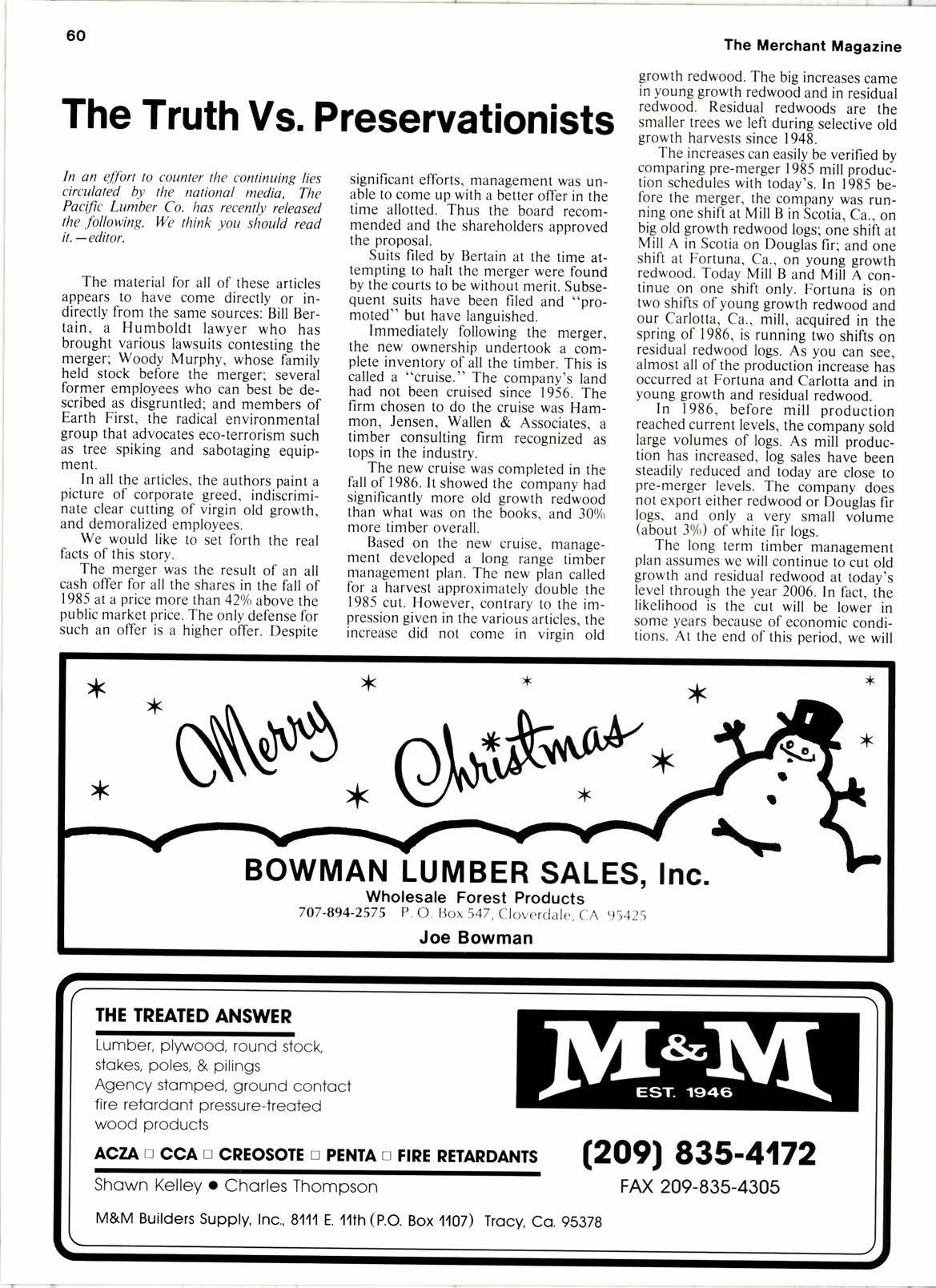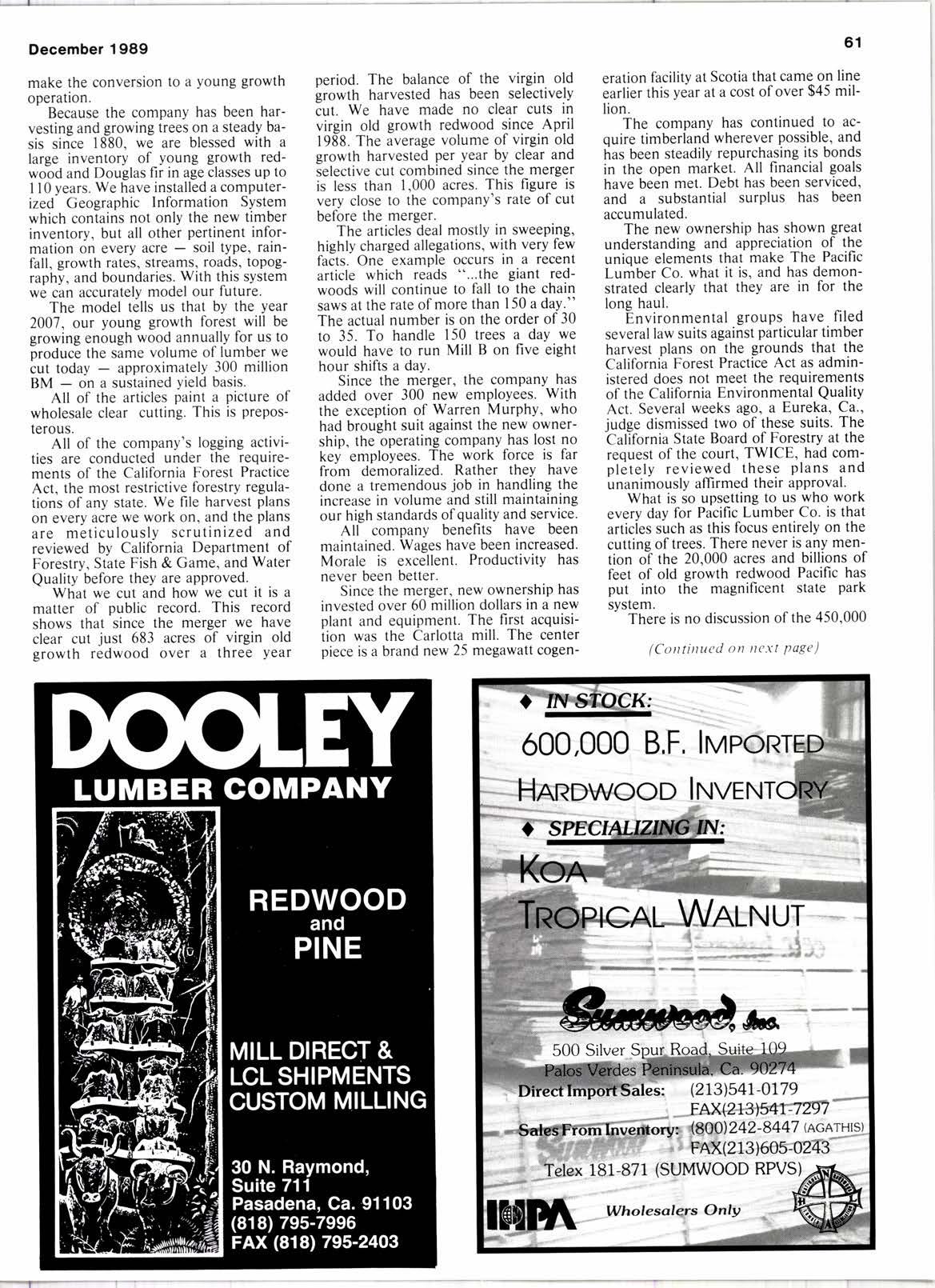
6 minute read
The Truth Vs. Preservationists
In an effort to counter the continuing lies circulated by the national media. The Paci.tic Lumber Co. has recenily released the following. We think you siould read it. -editor.
The material for all of these articles appears to have come directly or indirectly from the same sources: Bill Bertain, a Humboldt lawyer who has brought various lawsuits contesting the merger; Woody Murphy, whose family held stock before the merger; several former employees who can best be described as disgruntled; and members of Earth First, the radical environmental group that advocates eco-terrorism such as tree spiking and sabotaging equipment.
. In all the articles, the authors paint a picture of corporate greed, indiicriminate clear cutting of virgin old growth, and demoralized employees.
We would like to set forth the real facts of this story.
The merger was the result of an all cash offer for all the shares in the fall of 1985 at a price more than 420/o above the public market price. The only defense for such an offer is a higher offer. Despite significant efforts, management was unable to come up with a better offer in the time allotted. Thus the board recommended and the shareholders approved the proposal.
Suits filed by Bertain at the time attempting to halt the merger were found by the courts to be without merit. Subsequent.suits have been filed and "promoted" but have languished.
Immediately following the merger, the new ownership undertook a complete inventory of all the timber. This is called a "cruise." The company's land had not been cruised since 1956. The firm chosen to do the cruise was Hammon, Jensen, Wallen & Associates, a timber consulting firm recognized as tops in the industry.
The new cruise was completed in the fall of 1986. lt showed the company had significantly more old growth redwood than what was on the books, and 30% more timber overall.
Based on the new cruise, manage- ment developed a long range timber management plan. The new plan called for a harvest approximately double the 1985 cut. However, contrary to the impression given in the various articles, the increase did not come in virgin otd growth redwood. The big increases came in young growth redwood and in residual redwood. Residual redwoods are the smaller trees we left during selective old growth harvests since 1948.
The increases can easily be verified by comparing pre-merger 1985 mill production schedules with today's. In 1985 before the merger, the company was running one shift at Mill B in Scotia. Ca.. on big old growth redwood logs; one shift at Mill A in Scotia on Douglas fir; and one shitt at Fortuna, Ca.. on young growth redwood. Today Mill B and Mill A continue on one shift only. Fortuna is on two shifts of young growth redwood and our Carlotta, Ca., mill, acquired in the spring of 1986. is running two shifts on residual red-wood logs. As you can see, almost all of the production increase has occurred at Fortuna and Carlotta and in young growth and residual redwood.
In 1986, before mill production reached current levels, the company sold large volumes of logs. As mill production has increased, log sales have been steadily reduced and today are close to pre-merger levels. The company does not export either redwood or Douglas fir logs, and only a very small volume (about 3olo) of white fir loss.
The long term timber-management plan assumes we will continue to cut old growth and residual redwood at today's level through the year 2006. In fact, the likelihood is the cut will be lower in some years because of economic conditions. At the end of this period, we will make the conversion to a young growth operation.
Because the company has been harvesting and growing trees on a steady basis since 1880, we are blessed with a large inventory of young growth redwood and Douglas fir in age classes up to I l0 years. We have installed a computerized Geographic Information System which contains not only the new timber inventory, but all other pertinent information on every acre - soil type, rainfall, growth rates, streams, roads, topography, and boundaries. With this system we can accurately model our future.
The model tells us that by the Year 2007, our young growth forest will be growing enough wood annually for us to produce the same volume of lumber we cut today - approximately 300 million BMon a sustained yield basis.
All ol the articles paint a picture of wholesale clear cutting. This is preposterous.
All of the company's logging activities are conducted under the requirements of the California Forest Practice Act, the most restrictive forestry regulations of any state. We file harvest plans on every acre we work on, and the plans are meticulously scrutinized and reviewed by California Department of Forestry, State Fish & Game, and Water Quality before they are approved.
What we cut and how we cut it is a matter of public record. This record shows that since the merger we have clear cut just 683 acres of virgin old growth redwood over a three Year period. The balance of the virgin old lrowth harvested has been selectively cut. We have made no clear cuts in virsin old growth redwood since April l9d'8. The iverage volume of virgin old s,rowth harvested per year by clear and ielective cut combined since the merger is less than I,000 acres. This figure is very close to the company's rate of cut before the merger.
The articles deal mostly in sweeping, highly charged allegations, with very few facts. One example occurs in a recent article which reads "...the giant redwoods will continue to fall to the chain saws at the rate of more than 150 a day." The actual number is on the order of 30 to 35. To handle 150 trees a day we would have to run Mill B on five eight hour shifts a day.

Since the merger, the comPanY has added over 300 new employees. With the exception of Warren MurPhY, who had brought suit against the new ownership, the operating company has lost no key employees. The work force is far from demoralized. Rather they have done a tremendous job in handling the increase in volume and still maintaining our high standards ofquality and service.
All comoanv benefits have been maintained. Wages have been increased. Morale is excellent. Productivity has never been better.
Since the merger, new ownership has invested over 60 million dollars in a new plant and equipment. The first acquisition was the Carlotta mill. The center piece is a brand new 25 megawatt cogen- eration facility at Scotia that came on line earlier this year at a cost of over $45 million.
The company has continued to acquire timberland wherever possible, and has been steadily repurchasing its bonds in the open market. All financial goals have been met. Debt has been serviced, and a substantial surplus has been accumulated.
The new ownershiP has shown great understanding and appreciation of the unique elements that make The Pacific Lumber Co. what it is, and has demonstrated clearly that they are in for the long haul.
Environmental groups have filed several law suits against particular timber harvest plans on the grounds that the California Forest Practice Act as administered does not meet the requirements of the California Environmental Quality Act. Several weeks ago, a Eureka, Ca., iudee dismissed two of these suits. The "California State Board of Forestry at the request of the court, TWICE, had compl6rely reviewed these plans and unanimously allrrmed their approval.
What is so upsetting to us who work every day for Pacific Lumber Co. is that articles such as this focus entirely on the cutting of trees. There never is any men-tion oT the 20,000 acres and billions of feet of old growth redwood Pacific has put into the magnificent state Park svstem. '
There is no discussion of the 450,000 (Corrtinued on ttc.\t Page )
( Co n t inu e Ll J ro nt p rt' r' io u s poge ) scc(llings wc plitnl eVcr) tear. 'l'hcrc ncver is unl ntention of the vrrst \'oung growth lirrests on the compunr''s I94.0(X) acrcs n'hich range up to ll0 r'ears in age lnd will provide us with l str:t.rirtcJ licld cut in 1rgpPs111r11.
There is no recognition that this huge runcl r igorous ) oung fbrest is growing at 6 to 7 I'i, a lear conrpared to zero gr.wth on thc r irgin old grou,th stands. Nor is the rc nrenlron thut thcsc \'oLlng. itctive lt, gro\ting trccs supplr" ntuch llorc oxvgcn to thc- lir thun rkres the stitgnilnt old grou th.
Thcfc ccftlinlr is no ntcntion ol'the prolirsiorr ol ri ildlilc in the young gfo\\lh lirrcsts. inclLrding large numbers ol sl)ottcrl ori ls ncsting. lirraging. and roosting. Nor clo ths bring up the comprrrrr''s lish rcurirrg porrcis that have supplicd ntorc thln.r()0.{)00 steelhead and srrlnrorr to thc I:cl .rncl Vun [)uzen rivers in the Ilist 1i ,,ears. .l here is no mention thitt thc contpiln)'s renraining r'irgin olcl grouth rcd*ood js definitcll not o1'pirrk qLralitl' It is not accessrbl.'. It is in highcr. stccpcr coLlnlr). It is nrircrl rrith I)ouglas lir. \luch of it is urcr iigc rrnil stilrting t() go dou n hiil. \lurc inrportlint it is sciltt.rL-d throLtgh itn ltcti\ cl\ r'llrrlgccl litrcst.
Nonc ol thc lrticles ntcntion Pilcillc I-r.rnrbcr ( o. rs lctirclv inrolrccl riith the Savc thc Ilcrlr.roocls [-cirgr.rc *orktng to










